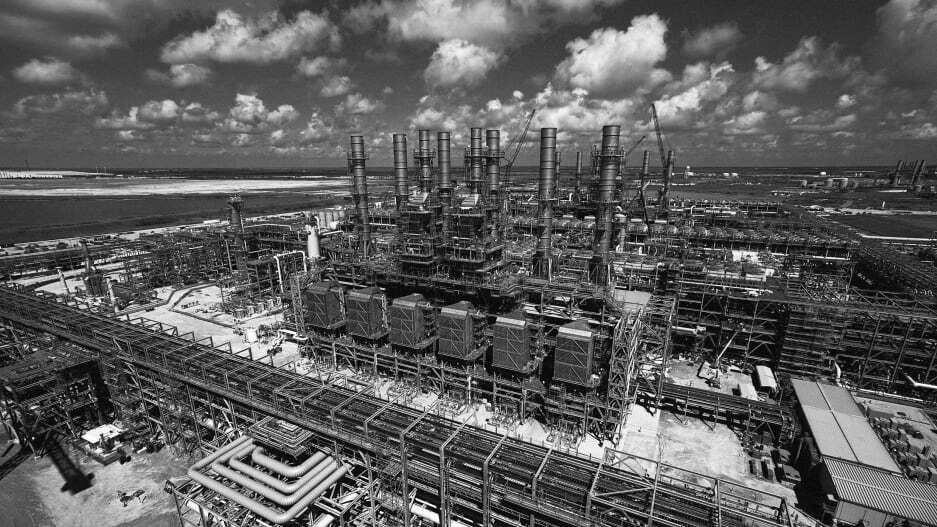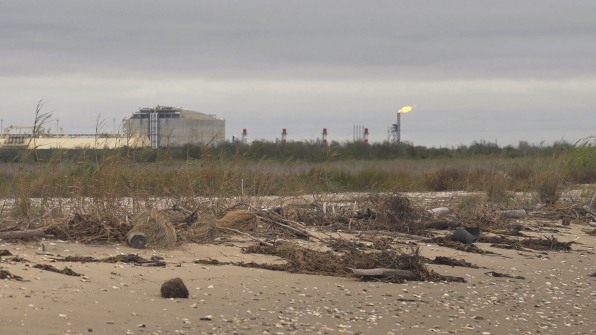- | 10:00 am
‘There will be no living here’: How gas exports are destroying Gulf Coast communities
New fossil fuel terminals release greenhouse gases and can be devastating to neighboring communities.

As an Indigenous fisherman from southern Louisiana, Travis Dardar knows what it’s like to have his home deemed unworthy of saving. Dardar grew up on Isle de Jean Charles, a small island in the marsh nearly washed away by storms, erosion, and rising seas.
In the early 2000s, the U.S. Army Corps of Engineers concluded that the $100 million price tag of including the island in a hurricane protection system was not worth it, and in 2016, the Department of Housing and Urban Development offered the state $48 million to resettle Dardar’s tribe. Dardar moved west to Cameron Parish, near the Texas border.
But his new home is no longer safe either.
Over the past seven years, Cameron Parish has become the site of three liquefied natural gas (LNG) export terminals.
These terminals, where natural gas is cooled into a liquid and loaded onto barges, emit highly potent methane, exacerbating a climate crisis that is battering Gulf Coast communities like Dardar’s. They also pose immediate risks to those who live nearby, releasing harmful pollutants, such as volatile organic compounds, nitrogen oxides, and benzene, and disrupting local fishing grounds.
From his home, Dardar can see the flames from an LNG facility burning off gas less than a mile away. “It’s very noisy,” he said. “At night time the flare is so big you could read a book outside by the light.”
The United States is experiencing a liquefied natural gas export boom. Though it only started to export the fuel in 2016, the U.S. became the world’s leading exporter in 2022, amid the ongoing Russian war in Ukraine and its disruptions to global energy supplies.
Today, the U.S. has seven LNG export terminals in operation, with plans for 20 more.

These terminals, where natural gas is cooled into a liquid and loaded onto barges, could emit more than 90 million tons of greenhouse gases a year—as much pollution as about 18 million combustion-engine cars a year—according to the Environmental Integrity Project.
They also hurt surrounding communities. Several studies have shown communities near so-called methane super emitters are at increased risk for adverse health outcomes, including respiratory and cardiovascular disease, due to pollutants released by these facilities. The export facilities pose many dangers, said Anne Rolfes, the founding director of Louisiana Bucket Brigade.
“They’re releasing pretty significant amounts of gas from a warming perspective,” she said. “Then you have to think about a hurricane coming. What does it mean for this area when these facilities are so poorly operated and it’s in a hurricane zone? What happens when you add a flammable facility in the mix?”
In June, an explosion at an LNG export plant in Texas rattled nearby residents and led to excess emissions of carbon monoxide, nitrous oxides, particulate matter, sulfur dioxide, and volatile organic compounds, according to a report filed with the Texas Commission on Environmental Quality. An export facility near Dardar’s home had five gas leaks and constant flaring in the first three months of 2022, according to Louisiana Department of Environmental Quality records.
“This is awful. Fishermen are moving out of Cameron Parish,” Rolfes said. “It’s because they’ve made the area unlivable.”
Commercial fishers like Dardar aren’t just worried about their health—they worry the terminals will also destroy their livelihoods. “Just the one they built already is too much and too close,” Dardar said. “They’re about to build another plant in front of this plant . . . That ain’t gonna work there. There will be no living here.”
Dardar said that the construction of additional export terminals would alter the coastal ecosystem, diminishing shrimp and oyster populations and putting him out of work.
Plans for one proposed terminal, to be operated by Commonwealth LNG, near Dardar’s home involve bringing in 60,000 truckloads of fill material to raise the site. That could prevent tidal flow in the marsh, which acts as a nursery for many juvenile fish species, according to communications between The National Marine Fisheries Service and Federal Energy Regulatory Commission (FERC). According to NOAA Fisheries, Commonwealth LNG recently agreed to monitor and minimize potential impacts to the marshes as a requirement for its U.S. Army Corps of Engineers permit, but the plan has not yet been approved.
In filings to the FERC, Commonwealth LNG concluded that the construction and operation of its LNG terminal and a 3-mile supply pipeline would not have significant environmental impacts or result in disproportionate adverse impacts to its neighbors.
“The plan they have right now will destroy the essential fish habitat,” said John Allaire, a retired environmental engineer who worked in the oil and gas industry for 40 years. Allaire, who lives less than a mile away from Dardar, expressed concerns that Commonwealth LNG had not presented a plan to restore the marsh ecosystem after the construction of its facility.
(Lyle Hanna, a representative from Commonwealth LNG, told Nexus Media News via email that the recommendations from National Marine Fisheries Service have been addressed by the company and provided to the U.S. Army Corps of Engineers. “Commonwealth LNG remains committed to environmental stewardship and working with the agencies,” he wrote.)
Dardar’s home in Cameron Parish is vulnerable to the effects of climate change, in addition to the localized risks of living near industry responsible for it. A category 4 hurricane made landfall in August 2021, followed by another hurricane two months later. Many of Dardar’s neighbors have not fully rebuilt.
The devastation wrought by climate change has made it difficult for locals to organize against the terminals, said James Hiatt, a coordinator with the environmental organization Louisiana Bucket Brigade.
“We can’t meet at a restaurant because there’s not one. We can’t meet at a courthouse ’cause there’s not one,” Hiatt said. Past storms have caused hazardous gas leaks and fires from nearby chemical facilities. While residents across Louisiana were dropped by their home insurers after the 2020 and 2021 hurricane seasons, fossil fuel firms are finding insurers to back them building LNG export terminals in hurricane-prone areas.
“How can they build these things directly on the coast when the residents who are there can’t even get home insurance?” Hiatt asked.
Federal regulators have raised similar concerns, arguing that companies should be required to share emergency response plans for hazards that could extend offsite with their neighbors and hire locals, they wrote during a recent deliberation process. They also noted that cumulative air pollution from the new LNG facilities would further burden nearby environmental justice communities.
Still, FERC regulators have continued to approve LNG export terminals, including Commonwealth’s, arguing that current rules don’t allow them to fully consider climate change or environmental justice impacts. Construction of the Commonwealth LNG export facility is slated to begin later this year, over the objections of local environmental groups, including the Louisiana Bucket Brigade.
Environmental groups called the approval “deeply flawed” in a request for a rehearing filed in December, a likely first step towards a lawsuit over the agency’s decision. The rehearing request claims that FERC failed to consider the cumulative impacts to nearby disadvantaged communities, where officials continue to allow companies to site LNG export facilities.
More than 40% of the population within 3 miles of the proposed Commonwealth LNG site live below the poverty level, according to Oil and Gas Watch data. An existing facility less than two miles away from Commonwealth, Calcasieu Pass LNG, has already disrupted residents’ way of life.
From his land, Allaire can see when the Calcasieu Pass LNG plant is flaring to release pressure or during an upset in operations. The stream of burning gas sounds like a jet engine. Burning natural gas with a flare converts it into carbon dioxide. Unburned, the gas traps exponentially more heat into the atmosphere than carbon dioxide.
Allaire worked in the petrochemical industry—including monitoring air and water permits—for 30 years and said that flaring should only be used in extenuating circumstances, not a nearly daily occurrence. Days before the Calcasieu Pass terminal began operation in January 2022, it leaked an unpermitted 180,000 pounds of natural gas into the air.
“I don’t see them putting one in by Martha’s Vineyard,” he said. “It’s absolutely a sacrifice zone.”
This article originally appeared in Nexus Media News.








































